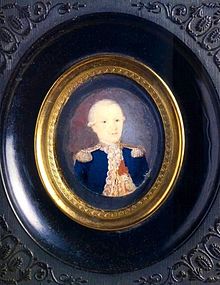Paul Antoine Fleuriot de Langle
|
Paul Antoine Fleuriot Vicomte de Langle |
|
|---|---|

Miniature portrait of Fleuriot de Langle
|
|
| Nickname(s) | Fleuriot de Langle |
| Born |
August 1, 1744 Kerlouët castle |
| Died | December 11, 1787 (aged 43) Tutuila |
| Buried | Choir of Saint-Louis Church, Brest |
| Allegiance | Kingdom of France |
| Service/branch | French Royal Navy |
| Years of service | 1758 – 1787 |
| Rank | Rear-Admiral |
| Commands held |
Experiment Astrée Astrolabe |
| Battles/wars | Hudson Bay expedition |
| Awards | Knight of the Order of Saint Louis Society of the Cincinnati |
Paul Antoine Fleuriot de Langle (1 August 1744, château de Kerlouët at Quemper-Guézennec, Côtes-d'Armor – 11 December 1787, Maouna, Samoa) was a French vicomte, académicien de marine, naval commander and explorer. He was second in command of the La Pérouse expedition, which departed France on 1 August 1785 and was eventually lost in the Pacific. Fleuriot de Langle died in an encounter with natives in what is now American Samoa before the expedition was lost; his remains were returned to France, and were buried in the choir of the church of Saint-Louis at Brest.
He was a member of the Académie de Marine from 1774. He commanded the 50-gun Experiment in the American Revolutionary War, and then commanded the frigate Astrée in the Hudson Bay expedition under his friend La Pérouse's orders.
For Fleuriot de Langle's expertise, knowledge of math and astronomy, and force of character, La Pérouse chose him as his deputy for his next expedition, commanding the 114-man frigate Astrolabe (accompanied by the Boussole) on a voyage of exploration into the Pacific Ocean. On the return voyage in 1787, fearing scurvy among his crew, Langle and La Pérouse landed on the Samoan island of Maouna to look for drinking water and fresh food, which they were running out of (Langle and La Pérouse both recognised the importance of fresh food in fighting scurvy, and Langle - unlike La Pérouse - was persuaded by the observations of Captain Cook that fresh water was also valuable in this regard). With their boats laden with water barrels, they waited for a tide high enough to rejoin their ship, but were in the meantime faced with ravishing young women, their hair decorated with hibiscus, advancing across the beach towards them and (according to the survivors' accounts) offering them sex. After many weeks at sea, these advances were evidently not unanimously rebuffed and extreme confusion and disorder followed.
...
Wikipedia
